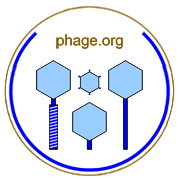

Study authored by A. H. Doermann published in 1948.
Doermann, A. H. 1948. Lysis and lysis inhibition with Escherichia coli bacteriophage. J. Bacteriol. 55:257-275. [PubMed]
Summary: Lysis caused by r+ and by r strains of the even-numbered phages active on E. coli strain B is studied both by means of plaque count methods and by turbidimetry. From the turbidimetric studies it is seen that one characteristic common to all the lysis curves discussed is an initial dip in turbidity, which occurs immediately after addition of the phage. Present evidence indicates that it is due to a reduction and recovery in the light-scattering properties of bacteria resulting from the phage infection. With high multiplicities of infection immediate lysis of a fraction of the bacteria is also induced, and this adds to the magnitude of the initial drop. A second drop occurs in all cases at the end of the normal latent period. This drop is, however, quite different with r+ infection from what it is with r infection. With the r phages it continues to complete clearing, but with the r+ phages it is small and is succeeded by a rise in the curve. This difference is the basic difference between r+ and r infections, and it has here been called lysis inhibition. After the period of inhibition a third drop in turbidity occurs, except with T2r+, and this drop represents complete clearing. ¶ The further analysis of lysis inhibition has yielded the following picture: the phenomenon requires that a bacterium be infected twice by r+ phages of the same or similar type; the second infection, if it is an infection by the same type of phage as the first, may come any time after the primary infection has been established, which takes about 3 minutes; present evidence indicates that a second infection by only a single phage particle will accomplish the inhibition. ¶ Lysis inhibition has the effect of increasing the burst size.
Contact web master. Return to terms.











